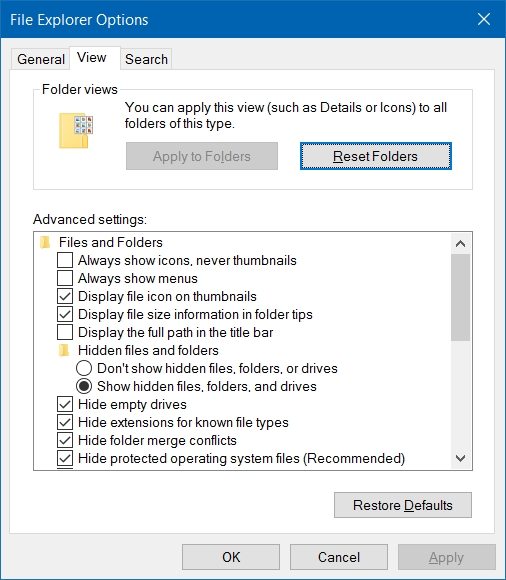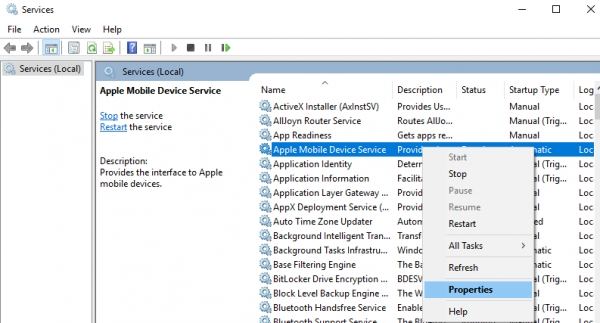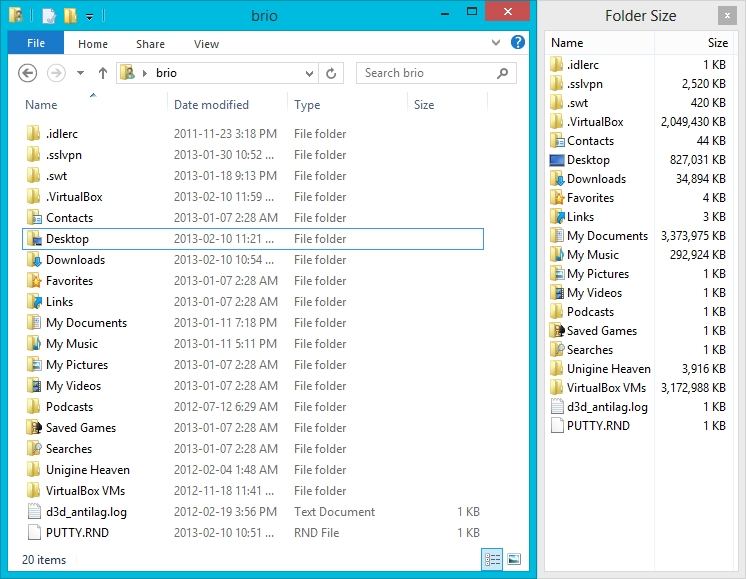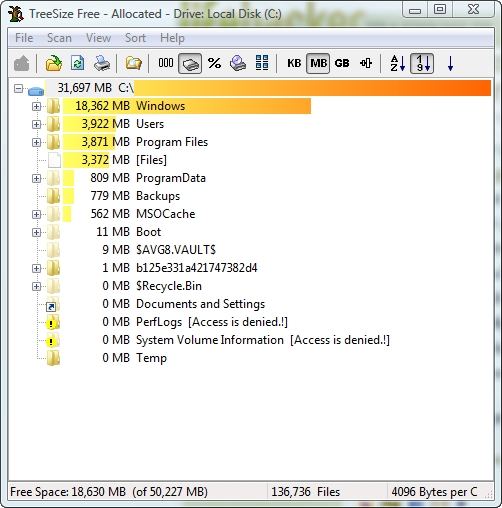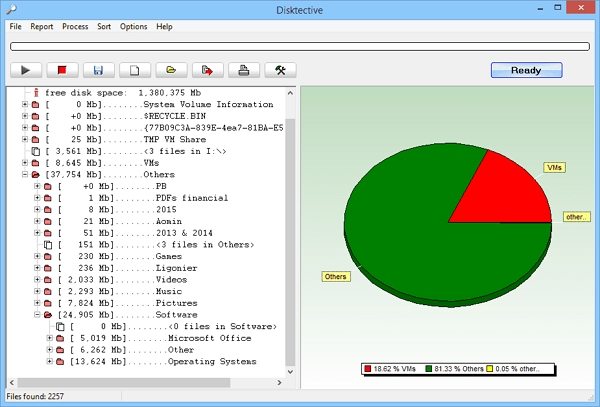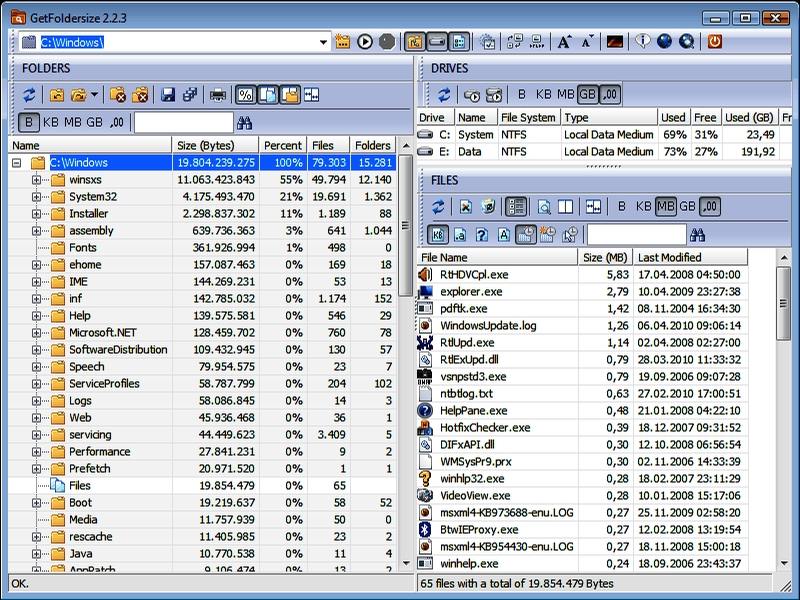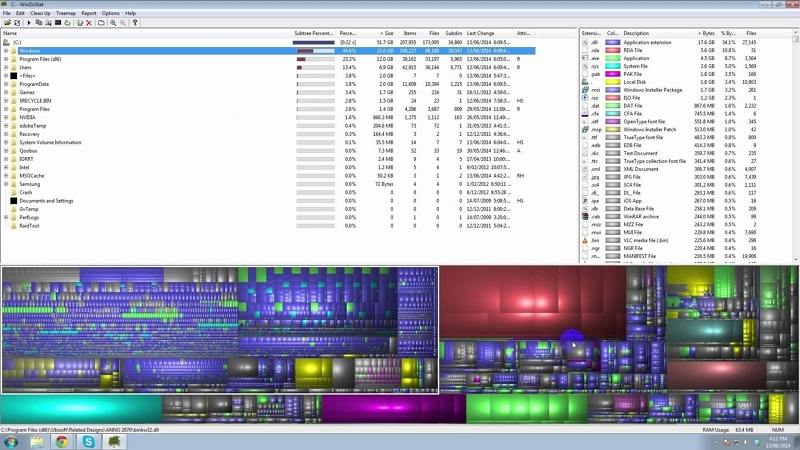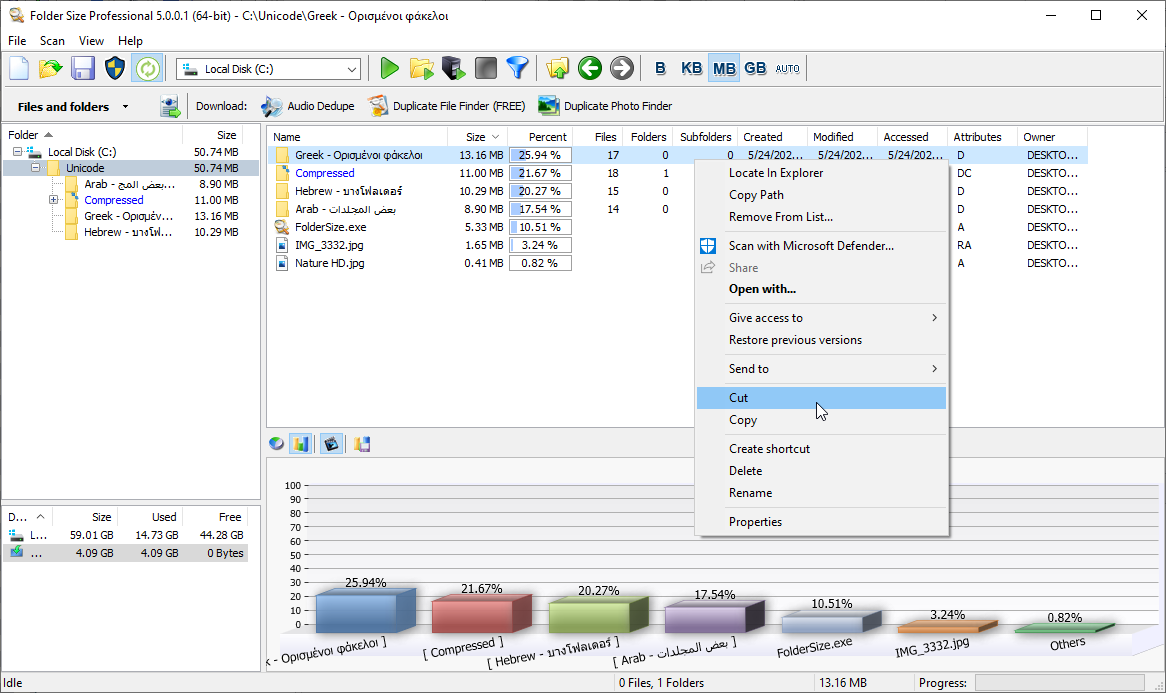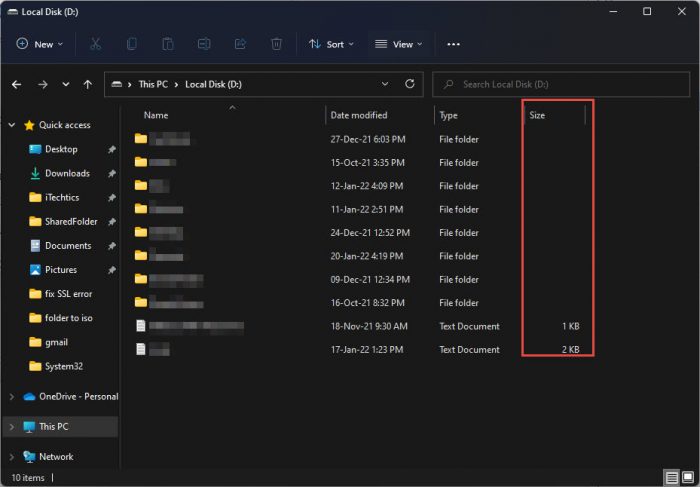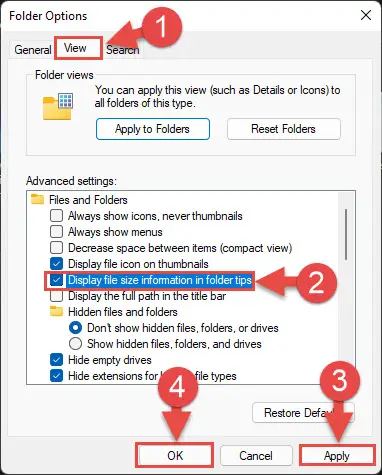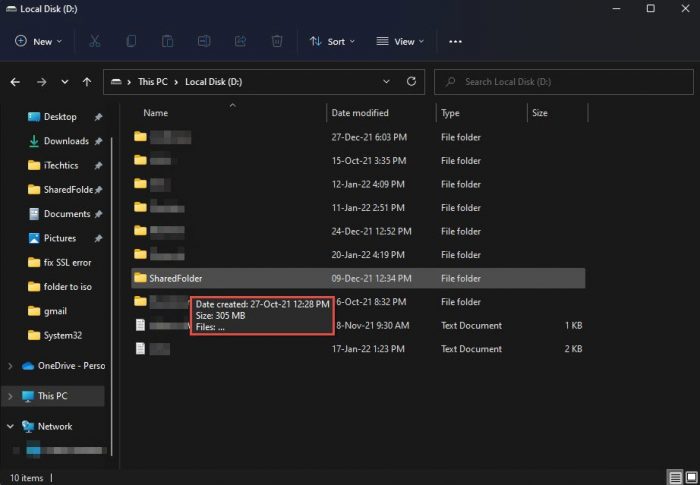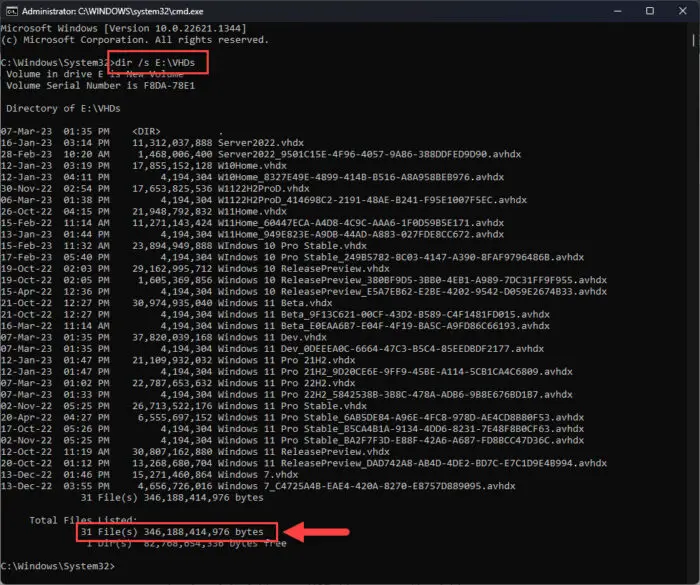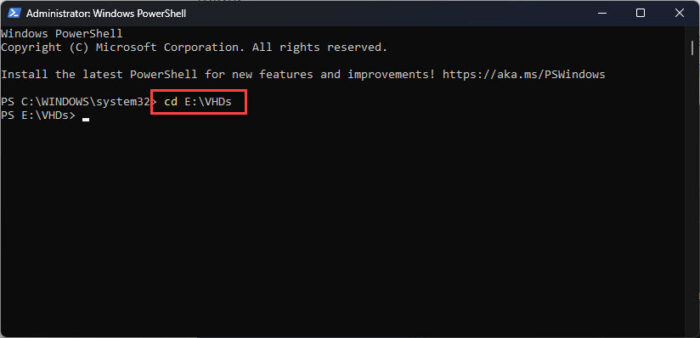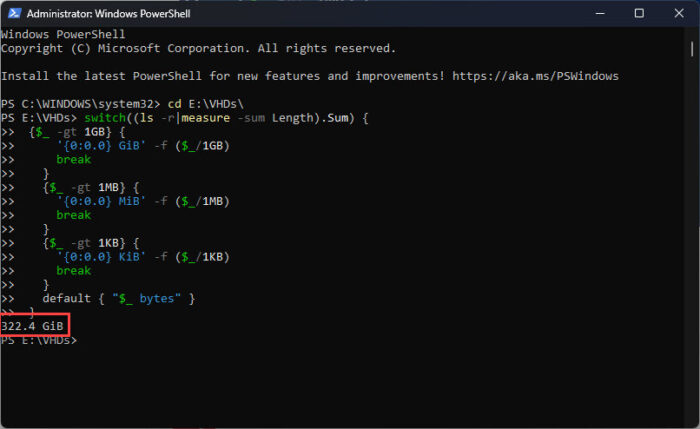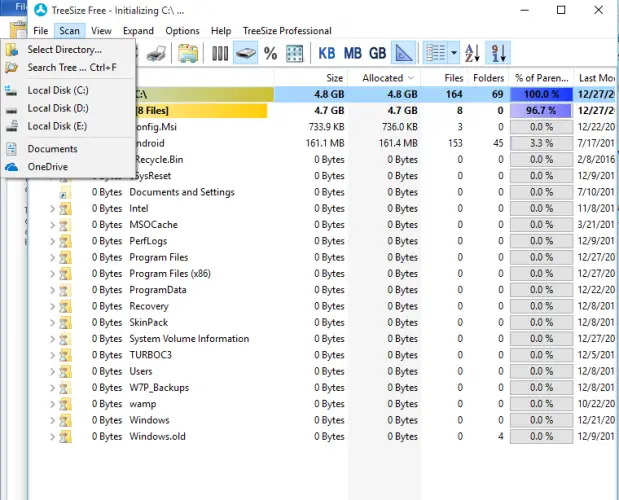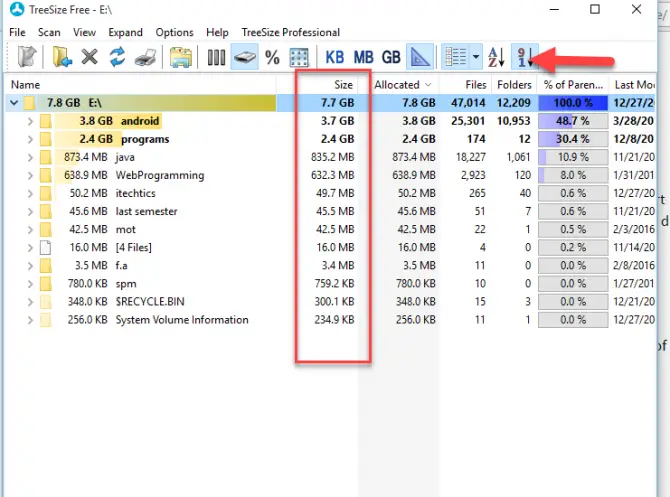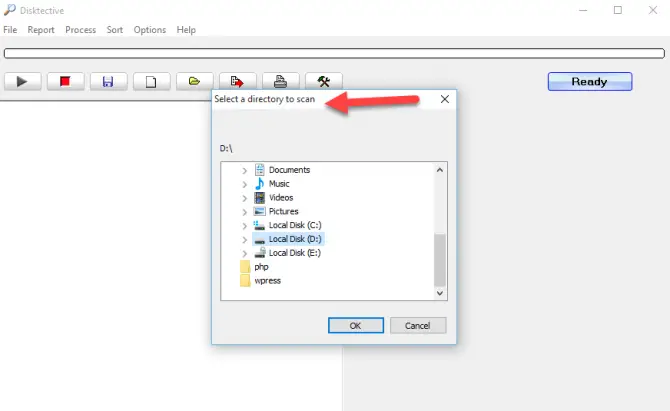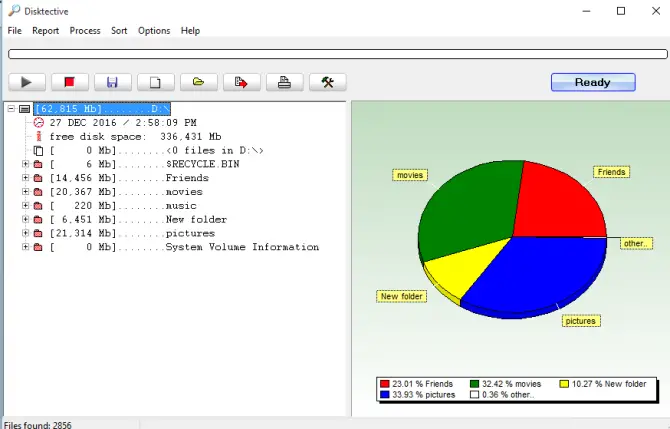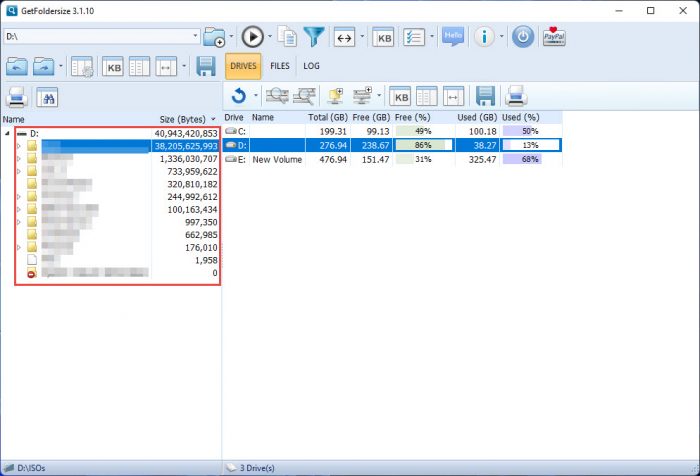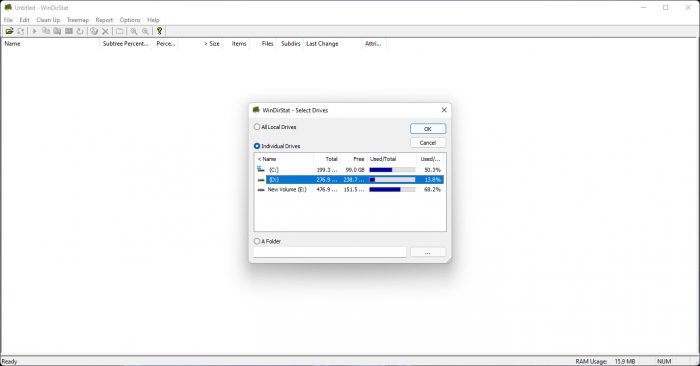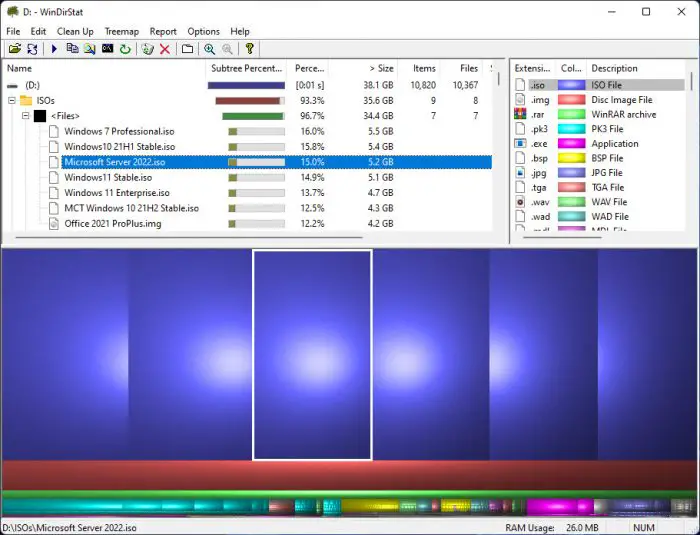There are 3 ways discussed in this article that focus on show folder size Windows 10. The main motive of each of these three ways is to resolve the issue of how to show folder size in Windows 10.
- Part 1. How to Show Folder Size in Windows Explorer?
- Part 2. How to View Folder Size in Windows 10 from Properties?
- Part 3. How to Show Folder Size in Windows 10 Using Apps?
Part 1. How to Show Folder Size in Windows Explorer?
Follow these steps for using Windows explorer to show folder size method:
• Go to File Explorer Options.
• Click on «View» tab.
• Tick the box beside the option «Display file size information in folder tips» in the advanced settings dialog box.
• Click on «OK» to save the changes.
• By following these steps folder size explorer Windows 10 can be used to see the folder size in Windows 10.
Part 2. How to View Folder Size in Windows 10 from Properties?
Another way to view folder size Windows 10 is to check it from properties. The size of files is well shown in the Windows File Explorer, but usually, the size of the folder is not shown up in it. Follow the steps mentioned to see the folder size using properties:
• Locate the file in Windows File Explorer.
• Make a right click on it and click on the option «Properties» in the drop-down menu.
• A window named as «[foldername] Properties» will pop up showing the folder size in «Size» and space occupied on the disk at «Size on disk» boxes respectively.
Part 3. How to Show Folder Size in Windows 10 Using Apps?
There are a few apps that can help in the process of viewing the folder size in Windows 10 PC. 5 of the most popular software are listed here for the said purpose:
1. Folder Size:
Folder Size software is free of cost and easily downloadable. After getting installed in the PC Folder Size add on a new column in the Windows File Explorer. This column shows the size of each file and folder. People like folder Size due to the facts that:
• It updates the size of the folders automatically when a change in folder occurs.
• No other application or program is required to be used for getting the information of the size of the folder.
• The size of the folder is shown only on opening the Windows Explorer. No need to scan each time the PC is turned on.
• If the folder is large, then it will be scanned in the background while allowing the user to perform other tasks.
Here is the download link of the same: http://foldersize.sourceforge.net/
2. TreeSize:
TreeSize is also a program that lets the user know about the size of the folder. Its main feature is to inform the user which folder is occupying more space on the disk, so that he or she can free up space. Just like Folder Size, TreeSize is also free. Download the .exe file from the following link and install it. After installation click on «scan» in the menu and select the folder to see the size of it. The user can also select an entire drive to see the size of all the folders within it. Sorting of the later can be done too by TreeSize. TreeSize is capable of showing the size of subfolders within the folders too by expanding the later.
Here is the download link for TreeSize: http://treesize-free.en.lo4d.com/
3. Disktective:
Disktective is a software platform to find out the size of the PC’s folders. The most preferred part of this software product is its user-friendly interface, which makes it easy to use and its portability. After installing the software from the link provided, the application will ask the user to choose the drive to scan. After selecting the drive, a quick scan will be done and the size of all the folders in the selected drive. A pie chart of the sizes will also be shown to the user for easier grasp of the space occupied by the folders. This software product also enables the user watch the size of external drives, i.e., CD/DVD or USB too.
Here is the download link: http://www.disktective.com/download/
4. Getfoldersize:
Getfoldersize is another application to judge the size of folders in the PC. It shows the size of all the folders in the whole PC in shape of a folder tree sorted by folder size. This categorisation helps the user to locate the trash files or empty folders no longer needed. The user can free up space simply by deleting the said. The most liked features of this application are:
• Its visual interface, which systematically shows the folders and sub-folders; this makes it easier to choose which file to remove and which folder/file to keep.
• All the ghost folders, i.e., unused or empty folders can be tracked down easily through this.
• The software can scan computers connected through the same network.
Here is the link to download the software: https://getfoldersize.en.uptodown.com/windows
5. WinDirStat
WinDirStat can show the disk usage statistics view and clean up the spaces for various editions of Microsoft Windows. WinDirSat scans the whole directory of the PC and then projects the results in three functional ways viz.
• Tree view of the directory list just like the Windows Explorer but more arranged according to the size of the file
• Treemap, this feature shows the entire subjects of the directory in the form of a tree.
• Extension list which depicts the statistics of the files and their types.
Here is the download link: https://windirstat.net
That’s all about how to show folder size in Windows 10. In addition, losing the account’s password can make people suffer a lot. But with the use of a simple tool named 4WinKey, one can easily deal with such problems. This simple software product can come in real handy for the problems related to a lost password of Windows 10 PC.
Free Download
Buy Now($19.95)
- Related Articles
- How to Disable Windows 10 Lock Screen
- The Top 3 Methods to Back Up Windows 10 PC
- How to Project Your Windows 10 Screen to Other TV or Projector
comments powered by
Show Folder Size Column in Windows Explorer
Folder Size Windows 11, 10, 8, 7 File Explorer
Windows Explorer is the core file management application in Windows. It lacks very useful information though — the Folder Sizes Column. There are several ways that you can display folder sizes in Explorer, but there is a better and free way to do it.
We will get into deeper details on how to display folder sizes in windows explorer further below. While those methods will help to inspect directory sizes, the FREE Folder Size application can do it much faster and easier. It is the best and easiest way to view folder sizes in Windows.
In addition to displaying all folder sizes, it can also list largest fails and largest folders. Find empty files and folders, list longest file names and paths, print folders tree, print files list, visualize disk space in neat pie and bar charts. It can view hidden backup folders and all hidden system files. Locate space hogs and recover lost disk space easily.
DOWNLOAD NOW
Compatible with Windows 11/10/8.1/8/7/Vista (Both 32 & 64 Bit)
Folder Size is a FREE tool that looks similar to Windows Explorer and will not only list the folder sizes, but it can also list the largest folders and files in your system in order to easily organize the disk space. While it may look inconvenient to use a separate application for that, it is easily accessible from Windows Explorer via the «Scan with Folder Size» menu. It is the best option that you have. If you insist on having the folder sizes listed inside File Explorer in Windows please read ahead.
Folder Size Explorer
Listing Folder Sizes in Windows Explorer
- Windows Explorer Context Menu — Scan with Folder Size
- Folder Size In Windows 10 Explorer
- Why Windows Explorer Does Not List Folder Sizes?
- List Folder Size — Performance Issues
- Folder Sizes Listing — Storage Health And Lifespan
- Directory Size Listing — Redundancy Issues
- Folder Sizes Data Integrity Issues
- Listing Folder Sizes Column Conclusion
- Viewing Folder Sizes In Windows Explorer
- View Folder Sizes Via Windows Explorer Properties Menu
- Show Folder Sizes As Windows Explorer Tooltip
- Do MacOS, Linux And Other Operating Systems List Folder Sizes?
Windows Explorer Context Menu — Scan with Folder Size
Folder Size adds a context menu item inside Windows Explorer. You can right-click any folder and select «Scan with Folder Sizes». That will list its size and that of all its sub-folders and files. If a copy of Folder Size is already running you can drag-drop a folder from Windows Explorer inside it to scan.
Listing the folder sizes is the least that the tool can do. There are many reports and options that will help you to organize the drive space. The «Largest Folder» and «Largest Files» reports will display the corresponding information for the currently selected folder and all its sub-folders.
Options to print folders and files and also their sizes are included too. The lists can be printed in many popular formats like PDF and TIFF as well as on paper.
There are beautiful pie and bar charts that make it easy to spot space hogs instantly. You can free up gigabytes of wasted space in just a few minutes. Use the reports and you will be able to find large files and folders that you have not used for ages. Remove them to recover disk space and improve the performance of your system.
Folder Size Charts
Enough about Folder Size — just download and try it. The tool is so easy to use that you do not need to read help files and user manuals. Now let’s move to the interesting question and specifically:
Why Windows Explorer Does Not List Folder Sizes?
While it may look very strange and unpractical, there are many reasons for that. First of all, that information is not contained in the file system. Unlike the files that have a size property, the size of the folder is not important for the proper operation of the system.
The file system is the underlying structure that holds information about the files and folders. That structure is often referred to as FAT. (File Allocation System) It is managed and maintained by the operating system. In order for the operating system to quickly display folder sizes the information has to be stored in the FAT.
List Folder Size — Performance Issues
There are hundreds or even thousands of files that are modified in your system every second. These are not the files that you are currently working on like documents, photos, or other personal files. These are internal files that are used by the operating system and the applications, needed for their core functionality. Now let’s imagine for a second what we need to do in order to constantly monitor the folder sizes. All file modifications will have to be monitored and every increase and decrease of a file’s size has to be written to the FAT. This information has to be written to the folder that contains the file and also to all parent folders that contain the folder where it is located.
As you can understand this will dramatically impact the performance of the file system and also the operating system. Such an impact can not be justified for a feature that is not important for the normal operation of the system. What would you prefer? A fast system that is missing folder sizes or a slow system that includes a feature that you do not need all the time.
Folder Size on the other hand runs only when you need it and scans only the folders that you want to analyze. That is why it will not have negative impact on your system. The tool does not run in the background. You launch it by clicking the «Scan with Folder Size» Windows Explorer context menu.
Folder Sizes Listing — Storage Health And Lifespan
Multiple writes to the file system reduce the life of the storage. This is especially true for modern SSD drives where the number of write operations is limited. Writing the change to the size of a file and folder and propagating it to all parents will have a very negative impact on the drive’s lifespan. Such sacrifice is really not justified for information that can be propagated and calculated on demand.
Again using the Explorer Folder Size context menu that our tool adds will keep your storage healthy. This is because the tool scans and displays the data only when you need it. It does not constantly monitor all file operations and it does not constantly recalculate and write folder sizes to the file system. It will only READ and calculate such information when it is necessary and will not write anything to your drives during the scan. Of course, you can save or export the folder size information after the scan is completed.
Directory Size Listing — Redundancy Issues
The file allocation table holds the bare minimum data needed to properly operate with the files and folders. Even the smallest increase in the size of that structure has a huge impact on the wasted space. If we add a single byte to the file/folder structure it impacts all the items in the FAT. Therefore it will be multiplied by the count of all the files and folders. That is why adding a folder size field that can be calculated from the already available data is not justified. A proper implementation would need at least 8 bytes per folder. If we need to add that to a drive with 1 million folders it will cost 8 million bytes.
Using the Folder Size Explorer context menu to calculate the folder sizes on demand solves both the redundancy and data integrity issues. As noted above the tool does not write anything to the system during the scan process. This means that it can not suffer from redundancy or data integrity issues. If a power failure occurs during the scan the only thing you need to do after restarting your computer is to run a new scan. As only READ operations are performed even if you kill the tool during the scan it will not cause issues with the file system.
Folder Sizes Data Integrity Issues
The other problem with the display of folder sizes is data integrity. All the core file system operations are designed to be performed as fast as possible. This is important in order to keep the file system in a healthy state. If a modification to the file system requires too many operations a failure in one of them may leave the system in an erroneous state. Let’s imagine that we have to keep information about every folder size. This means that if a file is resized we have to update the data of every parent folder that includes it. Now if a system crash or power outage occurs this process will be interrupted. As a result, many folders will have incorrect sizes. We already commented in the performance section that thousands of files are modified every second.
What has to happen in this case is that when the operating system starts the folder sizes have to be recalculated which may require a lot of time on large volumes and slow drives.
Listing Folder Sizes Column Conclusion
As you can see, while it would be great to have the folder sizes listed in Windows Explorer the drawbacks are much more than the benefits. I personally would love to see the data integrated into Windows Explorer, but would not sacrifice the performance of my system or the life of my storage device. Maybe in the future, a new method of storing data will be developed that will make it easy to store folder size, but at this point, it is not a task that is worth the drawbacks.
Viewing Folder Sizes In Windows Explorer
Windows Explorer probably is the most used application in the operating system. It provides many features that make it easy to work with files and folders. Along with the local drives, this also includes network locations and external storage. There are many ways to view the folder sizes in Explorer. We will take a look at them and analyze their practicality.
View Folder Sizes Via File Explorer Properties Menu
The context menu is the menu that appears when you right-click an item. Right-clicking a folder item provides a pop-up menu entry named «Properties». When you select «Properties», Windows Explorer displays the folder properties and at the same time starts to calculate its size. This usually is sufficient for viewing a folder’s size, but you have to do this on every folder that you want to examine. The other small annoyance about the feature is that it does not display when the operation is completed. Sometimes it stays a long time without updating the size and you can assume that it has finished before it ends.
Show Folder Sizes As Explorer Tooltip
Another option is to hover over a folder and a tooltip is displayed with the folder’s size. Of course, this is not any faster than using the «Properties» menu. Actually, it works only on smaller folders and may cause problems in network locations. Though it seems more convenient, it may not always be accurate. This makes it something that can not be relied on.
Do MacOS, Linux, And Other Operating Systems List Folder Sizes?
As we discussed earlier the folder sizes are a feature of the file allocation system. Currently, there are no common file systems that implement such features. All contemporary operating systems rely on similar methods like in Windows to calculate and display Folder Sizes. There are many external tools like Folder Size for Linux and macOS. As of now Folder Size support only Windows.
Folder Size is FREE and will solve the problem of missing folder sizes in Windows Explorer.
Applies to:
Windows 11 / 10 / 8 / 7 / Windows Vista / Windows XP / Windows 98 including x86 and x64 32 bit and 64 bit operating systems.
Supported server OS: Windows Server 2003 / Home Server / Server 2008 / EBS 2008 / HPC Server 2008 / Server 2008 R2 / Home Server 2011 / Server 2012 / MultiPoint Server / Small Business Server
First published on TECHNET on May 08, 2009
Good morning AskPerf. Today’s post is a very short one, but it does address one of our most common Shell / Windows UI questions. That question is, “Why can’t I see the size of folders in Windows Explorer?” The simple answer is that the behavior is by design. You can view the size of folders by hovering over the folders in Windows Explorer (as shown below):

The primary reason why the Windows UI does not provide this functionality is performance. Every time you navigate through a folder structure in Windows Explorer, the OS would have to perform a recursive scan of the subfolder structure within each folder to get the file and folder sizes and add them up. This would create significant processor overhead – especially if you think about scenarios (home folders for example), where the nested directory structure
for each user
may be several levels deep and consist of thousands of files and folders. Extend the scenario from the local machine and add in users who are browsing through a directory structure across the network and the performance hit would grow exponentially.
The hover behavior above is governed by the “Display file size information in folder tips” setting on the View tab in Folder Options:

There are instances where turning this option off may provide a performance increase (for example, complex, multi-level nested folder structures) on the local system. When viewing complex folder structures across the LAN/WAN, client machines may experience significant delays. One other setting to be aware of is the
NoRemoteRecursiveEvents
registry setting (HKLM\Software\Microsoft\Windows\CurrentVersion\Policies\Explorer). When this value is set to
1
, Change Notify requests are turned off for file and folder changes occurring in mapped network share subfolders. If a file or folder is change in the root and first folder level of the mapped share, a Change Notify event is still sent by the server. However if a change is made at the second level (or deeper) in the structure, no Change Notify is sent. This registry setting is set on the client machines.
Additional Resources:
-
Microsoft KB 831129: Folder tree flickers when you view a mapped network drive in Microsoft Wi…
-
Microsoft KB 885189: Slow performance when you use a mapped drive to copy files to a remote se…
— Prabhakar Shettigar
Quick Solution
Right-click on the folder and click “Properties.” Here, you will see the complete size of the folder. However, this method is not the best one if the folder size is too large. You can also use “dir /s [PathToFolder]” in Command Prompt to instantly get the size of any folder.
Your system may become very slow in performance, as the space in your disk fills up with all your files and programs. It would be helpful to know which folder is what size, so you can delete unwanted content from that particular folder to free up some space.
Unfortunately, Windows File Explorer does not show the folder sizes. Only file size information is shown when the View is set to Detailed under the File Explorer options.
There are a few methods to display folder size inside File Explorer, and other methods to view it too.
There are also a few ways to view the sizes of each folder, so you know which folder consumes the most space on your disk. There are also some utility programs as well through which we can check the folder size.
In this article, we will discuss some native ways, as well as third-party programs, through which you can easily check folder size in bulk.
Table of contents
- Quick Solution
- View Folder Size in File Explorer
- By Hovering
- Through Folder Properties
- View Folder Size using Command Prompt
- View Folder Size using Windows PowerShell
- Utility Programs to Show Folder Sizes
- Folder Size
- TreeSize
- Disktective
- GetFolderSize
- WinDirStat
- Closing Words
- Frequently Asked Questions (FAQs)
- Why doesn’t Windows show folder size?
- How can I check multiple folder sizes in Windows?
- Is it possible to show file size in MB in Windows Explorer?
View Folder Size in File Explorer
There are two methods for showing folder size in Windows Explorer natively, without having to use a third-party application.
By Hovering
One way to check the folder size in Explorer is to open File Explorer and hover your mouse pointer over the folder you want to get the size of. If you hover for a few seconds, it will open a small tooltip where you can see the folder size, among other information.
If you do not find the Size information in the snippet, the option has likely been turned off. Follow the steps below to enable it:
-
Open File Explorer, click the ellipses (3 dots) from the top, and then click “Options.”
Open Explorer options -
Switch to the View tab and then check the box next to “Display file size information in folder tips” under Advanced Settings. Then click Apply and Ok.
View file size information in File Explorer
You should now be able to see the folder’s size by hovering over it, as in the image below.
Through Folder Properties
Another way to know the folder size is to right-click on the folder and select “Properties.” Although this is not the most convenient way, it is still possible without a third-party app.
Right-click on the folder and click “Properties” from the context menu. The open window will display folder properties that include folder size, the size of the folder on the disk, the number of sub-folders and files inside the folder, its creation date, and other attributes. You can now see the “Size” of the folder it takes up on your disk.
Both methods tell the size of a folder. However, this only shows the size of one folder at a time.
View Folder Size using Command Prompt
You can also view the size of a folder using the Command Prompt. Here is how:
-
Launch an elevated Command Prompt.
-
Use the following cmdlet to display the size of the folder (in bytes) while replacing [PathToFolder] with the complete path of the folder:
dir /s [PathToFolder]View folder size using Command Prompt
Alternatively, you can also use the CD cmdlet to change the directory to the folder you want to know the size of, and then run the command “dir” to view its size. The results will be similar to the one we have discussed above.
View Folder Size using Windows PowerShell
Alternatively, you can also find the size of a folder using a PowerShell script. Of course, you will first need to allow running scripts within PowerShell. Click on the link to learn how, and then use the following steps to view any folder’s size in PowerShell:
-
Run an elevated PowerShell instance.
-
Change the directory to the folder of which you want to view the size using this cmdlet:
CD [PathToFolder]Change directory in PowerShell -
Now copy and paste the following script in Powershell and hit Enter.
switch((ls -r|measure -sum Length).Sum) { {$_ -gt 1GB} { '{0:0.0} GiB' -f ($_/1GB) break } {$_ -gt 1MB} { '{0:0.0} MiB' -f ($_/1MB) break } {$_ -gt 1KB} { '{0:0.0} KiB' -f ($_/1KB) break } default { "$_ bytes" } }View folder size using Windows PowerShell
The script used in the method above will automatically convert the size of the folder into GBs, MBs, or KBs – whichever seems appropriate to the script.
Utility Programs to Show Folder Sizes
There are a few reliable folder size Explorer apps that can help you check the folder sizes of all the folders in the drive.
Folder Size
Folder Size is a free-to-use tool that you can easily download.
Download Folder Size
When you install it in a few easy steps, the tool will add a new column in your Windows Explorer, which shows the size of the folders as well as the files. So by viewing the size you can easily see which folder is taking up the most amount of space on your disk.
Main features:
- It automatically updates the folder size when changes occur in a particular folder.
- You don’t need to use any other program or open anything else to view the size of the folder.
- It doesn’t scan anything upon startup. It shows the size of each folder when you open Windows Explorer.
- Large folders will scan in the background.
Whenever you start the system, a window will pop up and tell you the size of the folders. But sometimes it becomes irritating for users.
Here is the solution for this. Just right-click on its icon from the Quick Access menu and uncheck the option for “Show Folder Size popups”. So now no pop-up will appear. Or you can also uncheck the option “Start on Windows startup”. This will prevent Folder Size from starting on Windows startup.
So this is one utility to check the size of a folder. Below are some more utilities for the same purpose.
TreeSize
TreeSize is another utility program that helps you clear your disk space by telling you the size of a folder, so you can delete some extra files from that large size folder.
Download TreeSize
TreeSize is free software for your Windows. Download and install the tool, and after installing it, click on “Scan” from the menu and choose the drive you want to check for its size.
After selecting a drive, you will see all the folders in this drive, and their sizes will also be displayed. You can sort them according to size.
You can also expand each folder to see the size of its subfolders. So this is how you can easily check the folder size of any of your folders and clean your disk by removing any unwanted content. This will also allow you to scan the folders present in any external storage devices, such as CDs, DVDs, or USB flash drives.
Disktective
This is another free utility to check the folders size of your system’s folders. It is easy and portable to use, and its interface is also user-friendly.
Download Disktective
When you install it, it will ask you to scan the drive.
After a quick scan, it’ll provide you with the size of each folder within the volume. A pie chart will also be displayed for a quick look at the size of your folders. The tool can also scan any folders that are present in any external storage drive.
GetFolderSize
GetFolderSize is another great utility to scan your system drives and obtain the size of each file and folder. The double-sided display of the tool helps you with quick navigation. The tool can be used in place of File Explorer, as it offers all the same functions, including the same options as the context menu in Explorer.
Download GetFolderSize
WinDirStat
WinDirStat is a great free-to-use utility that tells you exactly which files and folders are taking up space. Once you install it, scan your entire disk or individual drives.
Download WinDirStat
Once the scan is performed, WinDirStat will display the size of each element as colored blocks, giving a visual representation of the size. You can then click on these blocks and WinDirStat will take you to the respective element. You may then remove any space-consuming content using the tool.
Closing Words
These are a few reliable and easy software to check the size of folders from your system so that you can clear the space on your drive by removing some extra folders that take up large space in your storage drives. You can choose any of them that you find best for you.
Frequently Asked Questions (FAQs)
Why doesn’t Windows show folder size?
From the very beginning, Windows Explorer has been unable to display a folder’s size in a dedicated column as an attribute. Although the individual item’s sizes can be seen, this is a feature many Windows users find lacking in Windows. Thankfully, you can view the sizes of folders using third-party apps like WinDirStat, Folder Size, TreeSize, etc.
How can I check multiple folder sizes in Windows?
You can check the size of multiple folders at the same time by either holding down the right-click of the mouse and selecting multiple folders or holding down the CTRL button and selecting multiple folders using the left click from the mouse. Once selected, right-click the folders and click Properties from the context menu. The Properties window will now display the accumulated size of all the selected folders.
Is it possible to show file size in MB in Windows Explorer?
Unfortunately, no. Windows Explorer will always show the file size in the smallest possible form, which is in KBs, or KiloBytes. If you would like to view the information in MB or GB, you will need to use a third-party application for it, such as WinDirStat.
Программа с открытым исходным кодом Folder Size (скачать) встраивается в Windows Explorer и отображает размер папок в отдельном окне.
Установите программу и откройте Проводник. Каждый раз, когда вы нажмете левой кнопкой мыши на папку, программа Folder Size вычислит и покажет размер всех вложенных папок и файлов.
Двойной щелчок на одну из вложенных папок покажет информацию о размере вложенных файлов. Если вы хотите просмотреть размер больших папок, таких как «Windows» или «Program Files», то исчисление может занять некоторое время.
Увидеть, что программа находится в режиме работы, вы можете по значку «плюс», находящемуся после отображаемого размера папки. Folder Size работает в фоновом режиме, чтобы отображать актуальный размер файлов и папок.
Завершить работу расширения вы можете через Панель управления и пункт «Программы».
Фото: компании-производители
